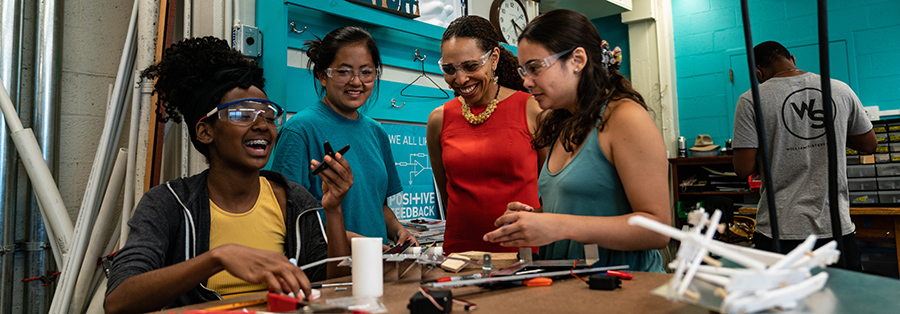
About
The MIT School of Engineering has long been a magnet for brilliant minds, hands, and hearts from across the globe. We believe a rich tapestry of perspectives, backgrounds, and experiences is vital to carrying out our mission of education and research with distinction.
We embrace and do our best to embody the Institute’s values of excellence and curiosity, openness and respect, and belonging and community. And we actively cultivate an inclusive atmosphere where faculty, students, and staff from all backgrounds can come together to pursue engineering with a passion for serious impact.
Our strategic plan guides us as we strive to build a community where every member can reach their fullest potential and make meaningful contributions to society.
Programs
As a leading engineering school, we consider it our responsibility to remove barriers, provide access, and create spaces that enable everyone to achieve their very best. We work toward this goal by offering programs at every level that focus on engineering excellence.
Pre-College
- MIT Introduction to Technology, Engineering, and Science (MITES)
MITES provides cost-free, transformative experiences that bolster confidence, create lifelong community, and build an exciting, challenging foundation in STEM for highly motivated pre-college students.
Undergraduate
- MIT Summer Research Program (MSRP)
MSRP instills a growth mindset in undergraduates by promoting the value of advanced education. The program, run by MIT’s Office of Graduate Education and supported by MIT’s School of Engineering, invites talented interns from underserved backgrounds to spend a summer on MIT’s campus conducting graduate-level research under the guidance of our faculty and postdoctoral fellows. - MSRP Fall Extension Program
MSRP Fall Extension Program enables participants who conducted research at MIT School of Engineering the preceding summer to advance their projects at their home institution. The interns are supported during the fall semester by a research stipend and virtually mentored by our faculty.
Graduate
- School of Engineering Program for Exemplary Mentoring
Program for Exemplary Mentoring (formerly University Center for Exemplary Mentoring) works to attract more underrepresented and underserved students to MIT’s PhD programs and to help ensure their success by providing a robust infrastructure of people, programs, and resources to help them fully integrate into our community. Founded with support from the Alfred P. Sloan Foundation and continued by the School of Engineering, PEM also works to expand the Institute’s current recruitment efforts and develop alliances that holistically look to recruit underrepresented and underserved students into STEM fields. - Rising Stars
Rising Stars offers professional development workshops for graduate and postdoctoral women and underrepresented groups who wish to explore careers in academia. The MIT-affiliated programs include Future Leaders in Aerospace Symposium, Rising Stars in Electrical Engineering and Computer Science, Rising Stars in Biomedical, Rising Stars in Mechanical Engineering, Rising Stars in Materials Science and Engineering, Rising Stars in Civil and Environmental Engineering, Rising Stars in Chemical Engineering, and Rising Stars in Nuclear Science and Engineering.
Postdoctoral
- MIT Postdoctoral Fellowship Program for Engineering Excellence
MIT Postdoctoral Fellowship Program for Engineering Excellence is committed to discovering and cultivating a community of scholars who not only excel in their research but also champion the values of inclusivity, understanding, and equality. In addition to an emphasis on research, the two-year program provides valuable resources and opportunities for the fellows to develop along three career paths: academic, industry, and entrepreneurship.
Faculty
- MIT Faculty Founder Initiative
MIT Faculty Founder Initiative aims to increase the number of female faculty members who start biotechnology companies through the MIT Faculty Founder Prize Competition, supported by Royalty Pharma.
Resources
MIT School of Engineering oversees several committees that foster a deeply inclusive, respectful, and caring community where each individual feels empowered and supported:
We collaborate with several cross-Institute offices and programs to support the engineering community. For more information and resources, you can visit the following websites: